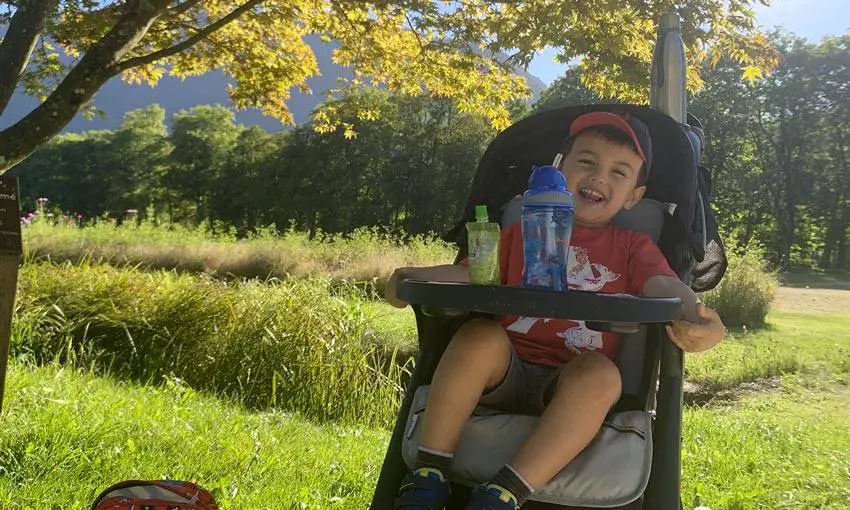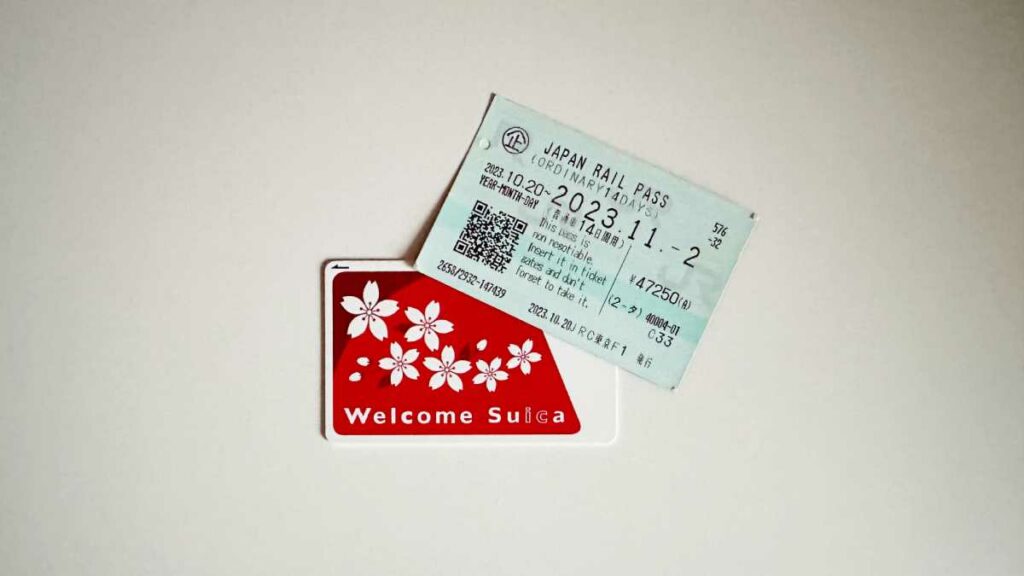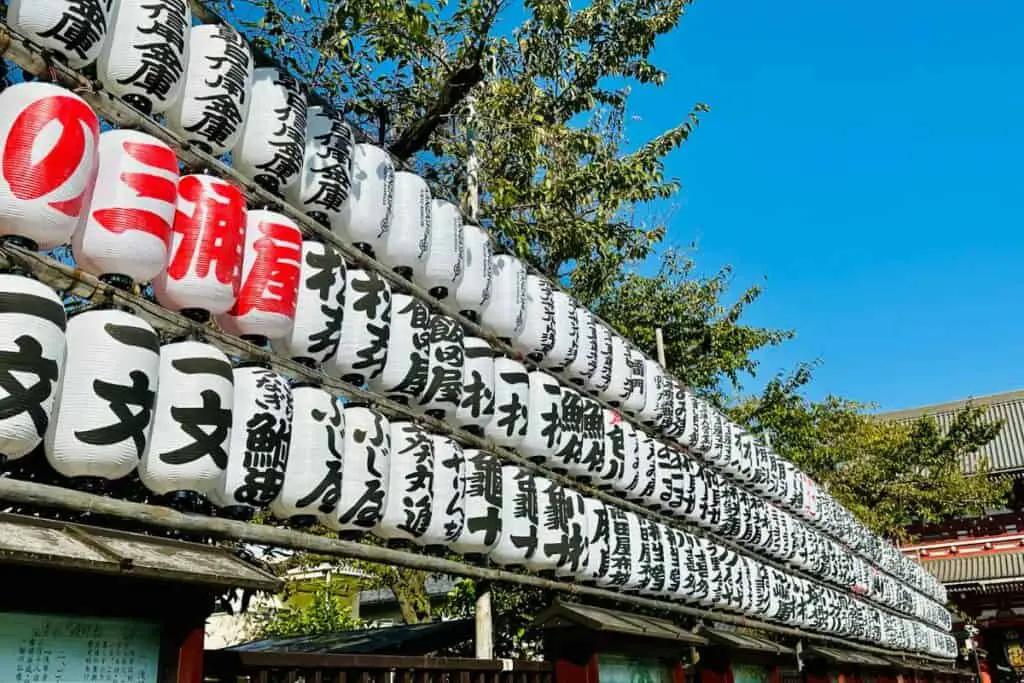When you’re planning your trip to Japan, you might have a hard time knowing what to visit first and there are so many things to visit that you start asking yourself if you will have the time to see everything. The answer is no, there will never be enough days to visit all that you have in mind. Nara is one of the most common day trips for tourists, people usually ask if it is worth spending a day in Nara or if you can skip it.
Nara is worth it for people interested in historical Buddhist temples, World Heritage sites, and the famous deer of Nara Park. It is also the home of the Great Buddha statue, the world’s largest bronze statue with 15 meters. Nara is a great day trip from Kyoto or Osaka.
But this is just the short version of what Nara has to offer. In the next paragraphs, we’ll see why Nara is so interesting for tourists, how much time you need in Nara, and how to get there from Kyoto or Osaka, the closest main cities you’ll probably be visiting.
What is Nara known for?
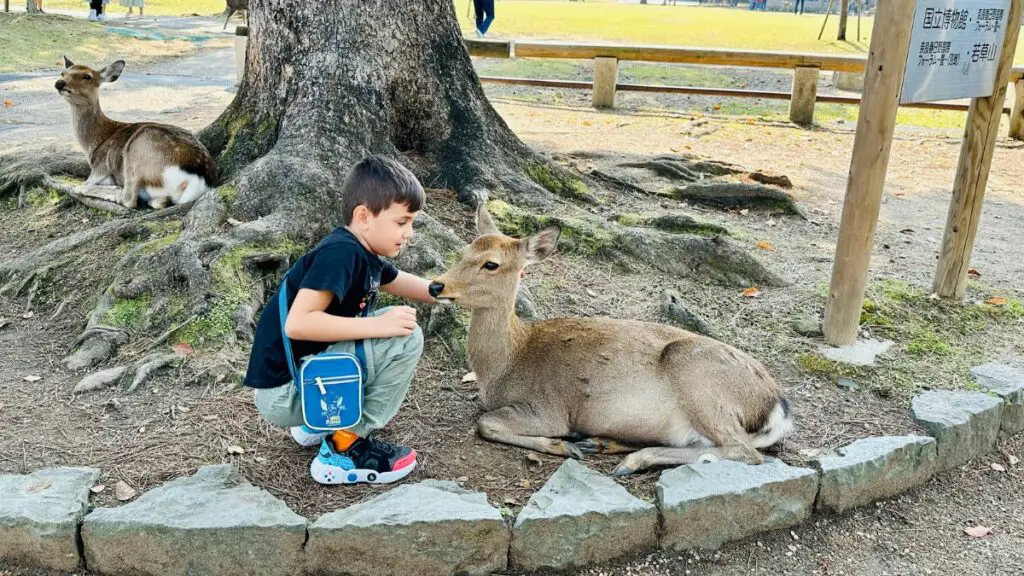
© Ana Costa
Nara is a place that has a lot to see, but one of the main reasons to visit is the UNESCO World Heritage sites of ancient Nara. This relatively small city has 7 World Heritage sites!
Todai-ji
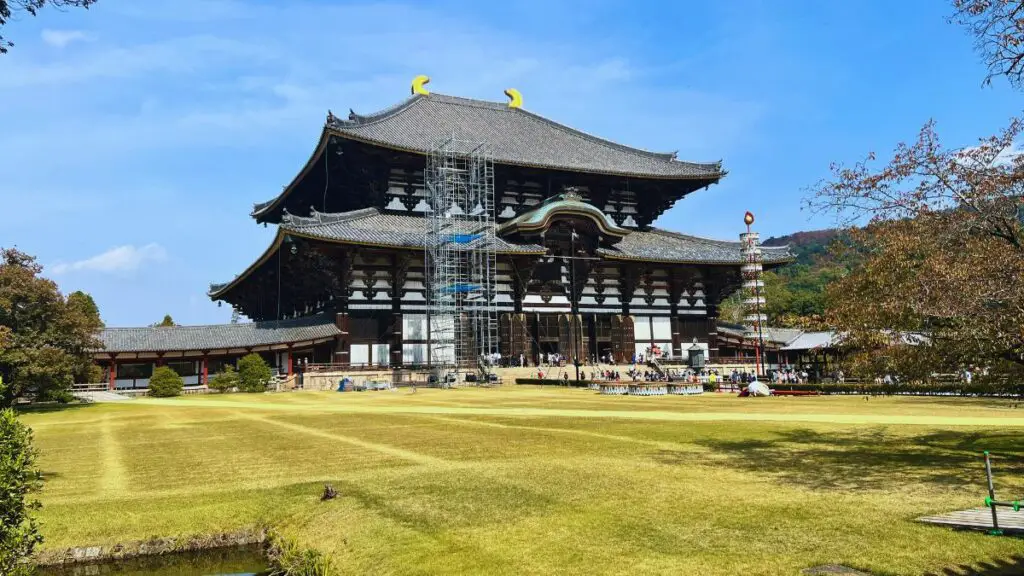
© Ana Costa
The Todai-ji temple is one of the most impressive wooden structures in the world. The temple complex includes several halls where you can enjoy a great Buddhist atmosphere. The Daibutsu-den is the most important hall with its 15-meter Buddha bronze statue. To give you an idea of how huge this statue is, the open hand of the Buddha is the size of a human being. This temple is certainly one of the most important things not to miss in Nara.
Check Todai-ji’s official website
Kofuku-ji
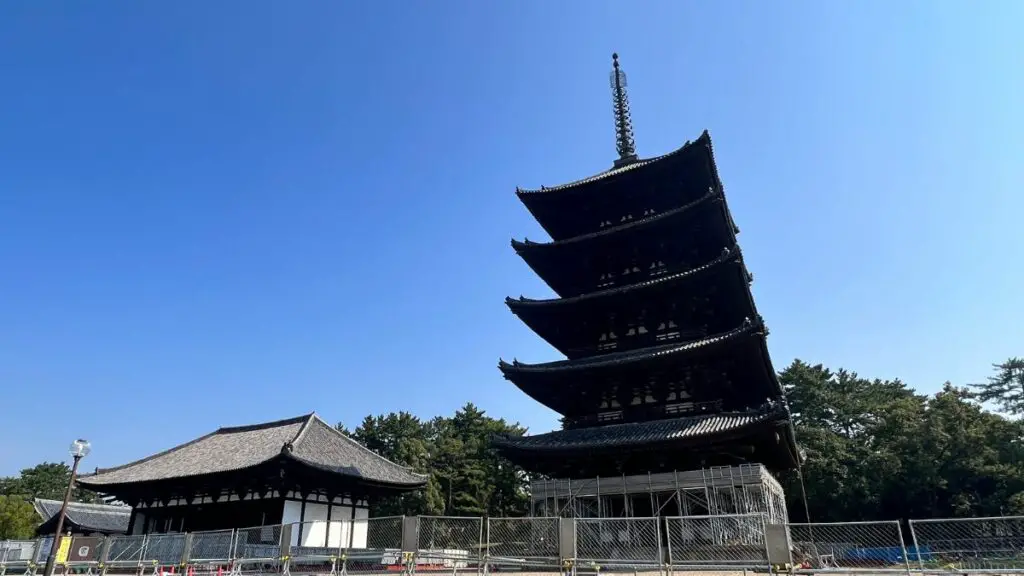
© Ana Costa
The Kofuku-ji temple is one of the first temples you will see when walking on the main road to Nara Park. This temple is known for its five-story pagoda which is the second tallest pagoda in Japan. There are also several other structures in the vast area of this temple so make sure you allow some extra time to appreciate the views.
Hey, check out these recommendations I have for you!
Before going any further, take a look at some of the recommendations I've handpicked for you. I think these are essential items you should have on your trip to Japan. You can check them out and buy them directly from Amazon.
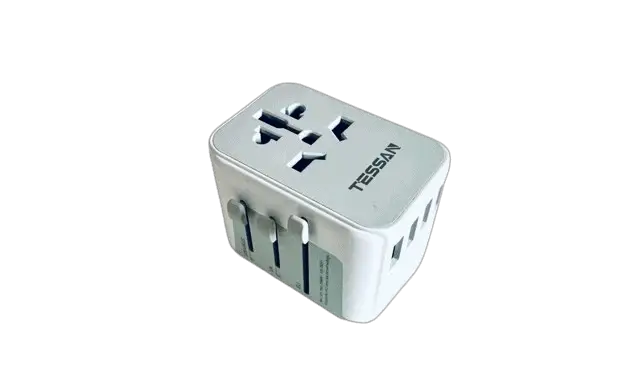
|

|

|
| A universal travel adapter | A 10,000 mAh power bank | A travel adapter and converter |
Unfortunately, when we visited in October 2023, there were a lot of renovations ongoing, but it was still nice to see these huge buildings.
Check Kofuku-ji’s official website
Kasuga Shrine
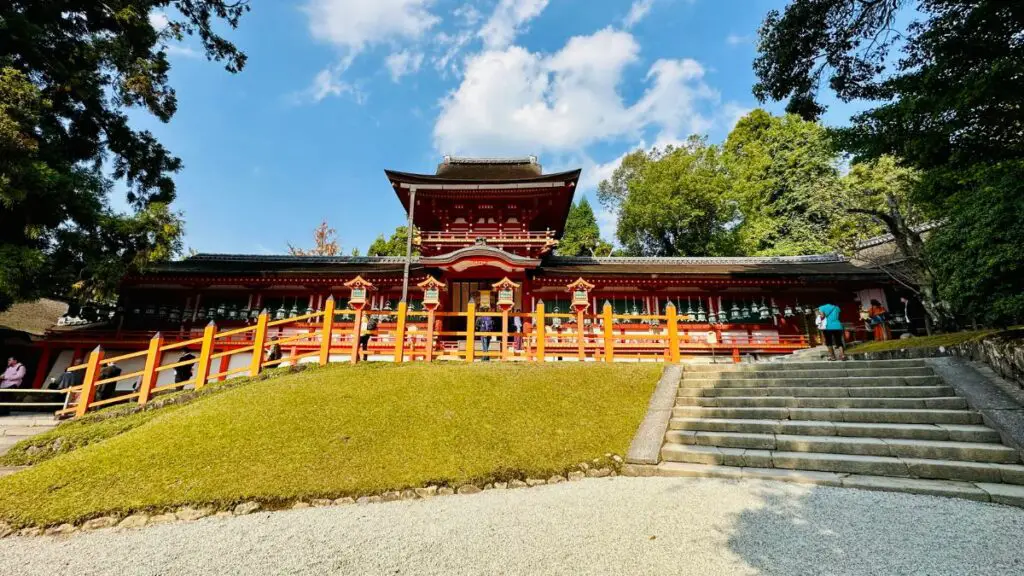
© Ana Costa
Near the end of the Nara Park area, you will find the Kasuga Shrine which is simply amazing. It is Nara’s most famous shrine and a must-see during your visit. The vermilion structures are astonishing and there’s an incredible path along the forest with hundreds of lanterns that are lit during the Mantoro Festival in February and August. If you get the chance to visit during these months, you will be rewarded with an everlasting memory.
Even if you go there on a regular day like we did, the path along the forest is very relaxing and beautiful. And you still find some deer roaming the area.
Check Kasuga Shrine’s official website
Kasugayama Primeval Forest
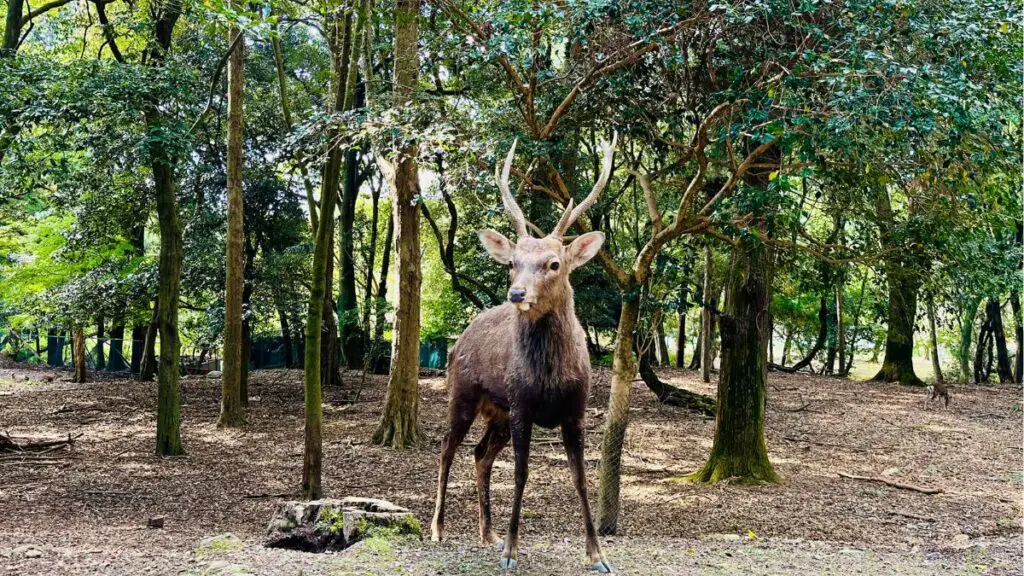
© Ana Costa
Behind Kasuga Shrine, you will find the sacred Kasugayama Primeval Forest. For more than 1,000 years now, this forest has remained untouched making some parts of the forest so dark that is hard to see even during daytime. There are some trails in the forest that you can take and where you will find a waterfall and small caves. From Kasugayama Primeval Forest, it is also possible to climb up to Mount Wakakusa where you’ll have an unbelievable view over Nara city.
We didn’t have enough time to explore the forest, but it’s something that’s on our list for the next trip to Japan.
Nara Park
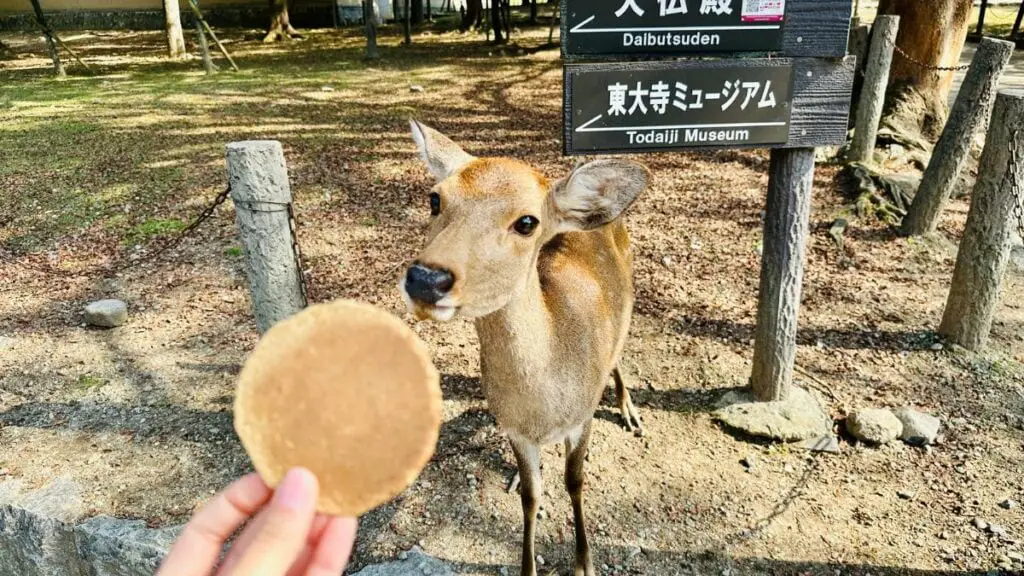
© Ana Costa
Nara is also known for the famous Nara Park, which covers around 660 hectares. The park surrounds Kofuku-ji, Todai-ji, Kasuga shrine, and Nara’s National Museum, so if you decide to visit Nara and the temples we saw above, you will inevitably visit the park.
The Nara Park is known mainly for its deer that you’ll see roaming freely around the park. There are around 1,400 deer and you will be seeing lots of them while walking around to visit the temples in the park. The reason for having so many deer is a religious one. It is believed that the deity enshrined in Kasuga shrine has ridden to Nara on a sacred deer, therefore deer are considered helpers of the gods and are protected in Nara as natural monuments.
You will be able to feed the deer with a particular type of crackers, called shika senbei, sold in the park and made specially for the deer. These crackers are the only thing you can give to the deer because every other food can kill them.
Notice that deer are wild animals so you must behave accordingly. That means you should never disturb the animals or try to grab them. Deer are used to be fed by humans, so they will approach you naturally. This is a common interaction that you can only experience in Nara Park (or maybe on Miyajima Island).
Insider tips for your Japan trip. Quick, easy, and free!
I Want This
By the way, if you want to know more about Miyajima Island, check my article about Miyajima with useful information for your trip.
A little heads up when you go to Nara Park early in the morning because the deer will be hungry 🙂 Indeed, the first visitors of the day usually say that the deer actively want the crackers, so they will likely follow you insistently. Take extra caution when visiting in the morning and also if you have small children with you. You can easily feel overwhelmed by all the deer gathering around you, so imagine how the little children might feel.
However, if visiting in the afternoon, walk a little further because the deer at the entrance probably won’t want to eat anymore. As most tourists stay at the park entrance, the deer there usually have more than enough food, but the ones further away don’t see as many tourists. For us, it was nicer to feed the deer at the back of the park because it was calmer.
The deer in Nara can do a little bowing trick that is fun to watch. If you raise the cracker with your hand and nod your head, the deer will nod back at you as if you were asking them if they want the cracker. Older deers are used to doing this trick, but younger ones learn fast and we found several that can do the trick too.
For those who don’t have any interest in the deer, it is still possible to walk through the park and enjoy nature and the beautiful historic sites. As I told you before, the deer will naturally come to you, but if you show them your empty hands, they will leave you alone and go search for other persons with food.
Check Nara Park’s official website
Nakatanidou
Nara is not only about temples and history, it also has some delicious food. I recommend visiting Nakatanidou which is located just 5 minutes on foot from Kintetsu Nara Station. Here you’ll find the best mochi in Japan and you’ll probably be able to watch their incredible and extremely fast technique. I bet you won’t regret it. However, the queue is very long and people start lining up at least one hour before the opening time.
On our last trip, we missed the chance to go there because the queue was huge on a Friday, so this is something we are planning for our next trip.
Check Nakatanidou’s official website
Gango-ji
The Gango-ji temple used to cover a much larger area of Naramachi, but fires have destroyed most of the original buildings. The few remaining buildings are protected as World Heritage Sites or National Treasures like a minuscule pagoda that is barely over 5 meters tall. It is certainly amusing to compare the giant five-story pagoda of Kofuku-ji Temple with this one. 🙂
This temple is not in the Nara Park area, but it is close enough. If you plan on visiting Nakatanidou, you can walk a little further and visit the temple too.
Check Gango-ji’s official website
Yakushi-ji
Yakushi-ji is a particular temple made in a Chinese style. Due to several fires, most of the buildings were burned down and the only structure that resists since its creation in the 8th century is the East Pagoda. All the other structures were reconstructed like the original ones. Another interesting feature of this temple is the main pagoda which offers an incredible optical illusion; it seems to be a six-story pagoda when it is just a three-story pagoda.
This temple is not located in Nara Park so most people don’t get to see it. It is a 20-minute bus ride from JR Nara Station, so it is not that close to the most common sightseeing places in Nara.
Check Yakushi-ji’s official website
Toshodai-ji
Just 10 minutes away on foot from the previous temple, you’ll find the Toshodai-ji temple. It is another beautiful and unique temple that is often compared to the famous Parthenon in Greece because the main hall was constructed using the same technique. Inside you will find an awesome statue that is considered the oldest wooden statue in Japan and it is also a National Treasure.
Check Toshodai-ji’s official website
Nara Palace Site (Heijo Palace Remains)
The Imperial Palace Site is an important place to visit if you’re interested in Nara’s history when it was the capital of Japan. Inside this huge area, you will be able to see the Daigokuden (former audience hall), the Suzaki Gate, and the East Palace Gardens which were recreated according to records of that time. There are still excavations going on on the site, so if you want to take a look, you can head for the Excavation Site Exhibition Hall.
Check Nara Palace Site official website
You may also like:
Is it Better to go to Nara or Kobe as a day trip?
What to do Around Fushimi Inari Shrine? (with pictures)
How much time do you need in Nara?
A great part of Nara’s main attractions are conveniently located, not far from Kintetsu Nara station. This makes it easy to see several things in a limited amount of time, so it’s not a surprise that the Nara Park area is the most visited by tourists.
Close to Kintetsu Nara station you will be able to visit, for example:
- Kofuku-ji Temple
- Nara Park
- Nara National Museum
- Ukimi-do Hall (scenic spot situated on a pond)
- Yoshikien Garden
- Todai-ji
- Rokuen Park
- Kasuga Shrine and Botanical Gardens
- Kasugayama Primeval Forest
Visiting all these attractions can be done in half a day if you keep a well-paced rhythm. This can be a good option for people wanting to see a good part of what Nara has to offer but don’t have enough time available. For instance, if you have figured out already your itinerary in Japan and forgot Nara, you can add a quick visit just focusing on what’s around Nara Park. Or maybe you’re in Japan at the moment, and you’re wondering if you should go to Nara.
But even if it is possible to see the most important attractions of Nara in half a day by doing everything quickly, I wouldn’t recommend that unless you have no other choice. This was what I did on my first trip to Nara, but I regret not staying longer to fully enjoy nature, and I also missed some cool activities.
Japan’s waiting for you! Get your quick guide for the best trip.
Grab It Now
You will need to take at least one full day to appreciate what Nara has to offer. Yes, the Nara Park area is the easiest place for tourists with a short amount of time available, but remember that you waste about one hour each way in transportation from Kyoto or Osaka so even if you intend to go to the Nara Park area alone, a day trip is better. There are also small shrines and temples in Mount Kasuga that are worth the visit because they’re a little isolated in the mountain, and that creates a beautiful atmosphere.
Everything is much more enjoyable if you take your time to appreciate the moment. Plus, if you want to take some cool pictures, you should allow a lot more time.
There are several tours available to visit Nara easily without having to worry about transportation and what you should see or not. Some companies even adapt their offer to provide half-day tours to meet the tourists’ needs regarding the time available.
Klook provides a half-day tour from Osaka to Nara in the afternoon for those with limited time, but you will only be seeing a few temples, spend a little time with deer, and make a stop at a souvenir shop.
Check Nara’s half-day tour from Klook >>
How do you get to Nara from Kyoto or Osaka?
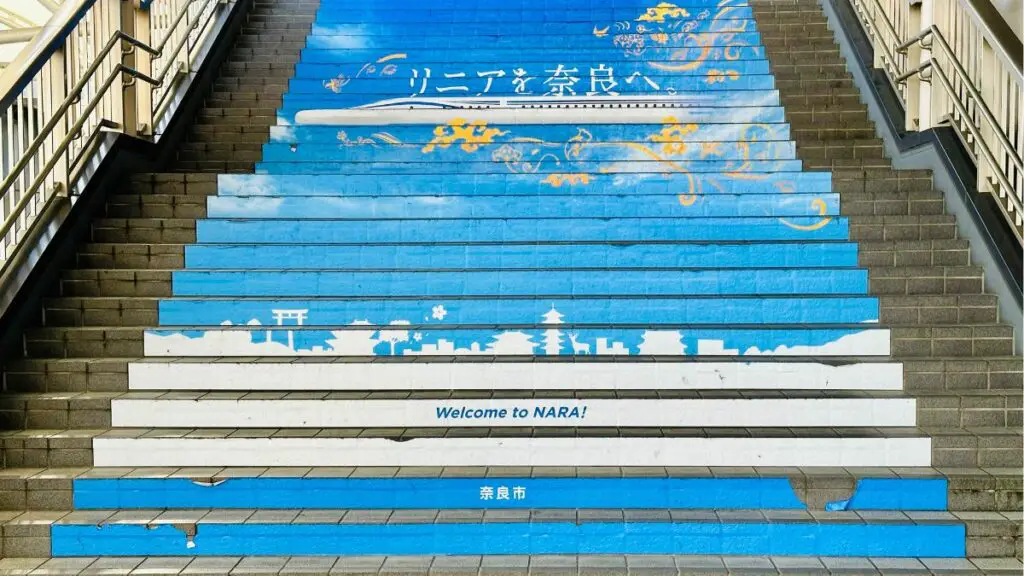
© Ana Costa
As Nara is usually a day trip from Kyoto or Osaka, I’ll give you the information needed to get there from these two cities. If you want to go to Nara from anywhere else in Japan, you will likely pass through Kyoto or Osaka anyway, so you just have to figure out your way to Kyoto and Osaka.
The first and most important thing to keep in mind is that there are two Nara stations: JR Nara Station and Kintetsu Nara Station.
JR Nara Station
If you bought a Japan Rail Pass or if you’re planning to buy one for your trip, this is the station you want to use because it’s included in the Japan Rail Pass (otherwise you’ll pay around 1,000 yen from Kyoto Station or Osaka Station, depending on the type of train you choose).
The JR Nara Station is located about 2O minutes on foot from the attractions in Nara Park. Some buses can take you from JR Nara Station to Kintetsu Nara Station (which is closer to the attractions), but it will take you the same time and costs about 220 yen (and you still have to walk from Kintetsu Nara Station to Nara Park). I don’t think it is worth taking the bus unless you want to reduce the walking at all costs.
We walked from JR Nara Station to Nara Park and we enjoyed doing it. On the way back, my son was a little tired, but we still went to JR Nara Station on foot again.
Kintetsu Nara Station
The Kintetsu Nara Station is located about 5 minutes on foot from Nara Park and it’s a good choice if you don’t plan to add extra walking to your itinerary.
| From | To | Time | Cost | |
| Kyoto Sta. | JR Nara Sta. | ~45 min | ~760yen | |
| Kyoto Sta. | Kintetsu Nara Sta. | ~35 min | ~1,280yen | |
| Osaka Sta. | JR Nara Sta. | ~56 min | ~820yen | |
| Osaka-Namba Sta. | Kintetsu Nara Sta. | ~37 min | ~680yen |
The time and cost might vary depending on the type of train you’ll be picking, but the table above gives you a pretty good idea of what to expect and what’s the best option for your itinerary. As a general rule, it’s better to travel to Kintetsu Nara station because it takes less time, but if you have a Japan Rail Pass it’s better to save the ticket money and go to JR Nara Station because this ride is included in the pass price.
Conclusion
Yes, Nara is worth the visit to take a break from the hustle and bustle of the city. Plus, it will have fewer tourists than Kyoto which makes the experience much more enjoyable (even if there are lots of tourists at the beginning of Nara Park). A day trip is probably the best option for most people, especially if you’re not an early bird. As you waste about two hours in transportation to Nara (round trip), that leaves you with a few hours to see what you want in Nara.
Nara is mainly historic sites, temples, and nature, so be sure that this is what you’re looking for in your trip. Even if Nara has the most massive and impressive temples, if you saw lots of them in the previous days you might be a little tired of temples. In that case, you can switch your itinerary to explore the city and find some great food experiences.
I’ll leave you with two downloadable brochures from visitnara.jp that might be interesting for your visit:
Download the Nara sightseeing map from visitnara.jp >>
Download the Nara Handbook from visitnara.jp >>

